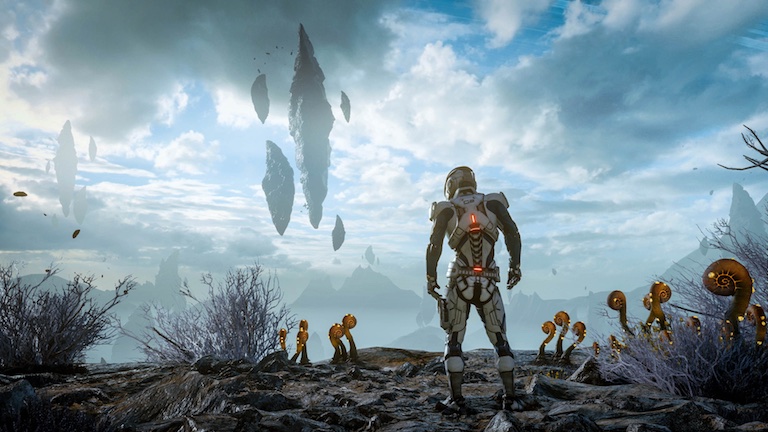Review: ‘Mass Effect: Andromeda,’ a voyage amongst the stars
Exploring new worlds and encountering new races of aliens — “Mass Effect: Andromeda” stems from events that took place between “Mass Effect 2” and “Mass Effect 3.” Players assume the role of human soldier Ryder, who just awoke from a 634-year cryogenic sleep after the “Mass Effect 3” story to the newly discovered Andromeda Galaxy. Ryder, along with other species of aliens from the Milky Way Galaxy, are part of a pioneer program known as the “Initiative.” The program was meant to be the guiding light for inhabitants of the Milky Way Galaxy as they tried to colonize in Andromeda on habitable planets known as “golden worlds.” Things do not go as planned, and Ryder is forced to lead both humans and the various other races to find habitable worlds while surviving the threat of outlaws, hostile creatures and a new alien race known as the Kett.
Though “Mass Effect: Andromeda” is the fourth game in the Mass Effect franchise, it does not follow the events from the previous trilogy. As such, new players should have no difficulty comprehending the story — besides knowing about alien races from past games like the Krogans, Asari, Salarians, and Turians.
However, this also proves to be a problem with the new narrative. “Mass Effect: Andromeda” is set in a new galaxy, but relies too heavily on the familiar. Despite it being a new galaxy, there are only two new races of aliens — the Kett and Angaran. Because of this, the galaxy doesn’t feel as big as it should. It seems like it recycles assets from the previous games in the series, such as the aliens, instead of bringing in new things. However, “Andromeda” manages to redeem itself due to the narrative choices and variety of planets in the game.
A Mass Effect trademark has always been its narrative choices and how they impact the rest of the game. This feature makes a return in the fourth addition to the series, and though some of them are not that important — such as deciding whether to release or exile a convict — there are still choices that have a crucial impact on the narrative. One of these game-changing narrative choices is deciding whether to give a planet-ruler a nuclear powered device so Ryder can build on their planet, as refusing to do so makes them an enemy. These types of situations breathe life into the setting and create an immersive experience that actually feels real.
The large number of planets also help with the immersion. “Mass Effect: Andromeda” is filled with planets for players to explore, catalog and even extract resources from. Each planet in Andromeda is distinctly different from the others, bringing new elements and variety to the franchise — unlike the shortage of new aliens. This diversity makes Andromeda feel like it is worthy of being called a galaxy. For example, one of the planets that Ryder explores early in the game is an ice planet covered with snow and harsh blizzards, which prevents the player from casually exploring in fear of dying due to the cold. There are also other dangerous planets such as a desert planet with intense temperatures that can cause Ryder overheat if the player is not careful. Though these planets are distinct, they are normally empty with long stretches of land. This means that the player will spend most of their time driving in a car-like vehicle called the Nomad to explore these planets. This mechanic may excite players who like exploration and world immersion. For me, however, this quickly became tedious.
Certain planets also contain a “vault.” These vaults terraform the planet to make it habitable. For example, the previously mentioned ice planet’s harsh blizzards are diminished when the vault activates, causing the sky to clear up and reveal a phenomenon similar to the aurora borealis — a sight that made this planet one of my favorites. This vault also makes the planet warm up, no longer restricting the player’s exploration with the possibility of a game over screen caused by hypothermia.
The combat in “Mass Effect: Andromeda” is also more fast paced than in previous games. Ryder is very mobile and can jump around the map, constantly moving to get the upper hand on enemies. Leveling up received some changes as well. The player still has skill tiers in which they can pick certain abilities, such as being more skilled with using an assault rifle or using telekinetic-like powers with their biotics. What is different from past games is the fact that players are no longer restricted in their future ability options due to the class they chose at the beginning of the game. This both opens up and diminishes the value of choice in the matter. Classes are no longer restricted, which means there is no point in having classes in the first place.
Multiplayer mode from “Mass Effect 3” also makes a return in Andromeda. It is still the standard seven-wave survival mode with a few random objectives, such as targeting specific enemies or capturing certain areas, implemented in each round. The multiplayer is a fun distraction that gives you the ability to unlock new characters and weapons from packs, creating an incentive to keep playing the game.
There were several technical bugs that I experienced while playing the game. Facial animations were a constant but minor issue. In dialogue sections, especially with the human characters, the way the face moved felt robotic and unnatural. There were also a few incidents in both multi- and single-player mode where I would literally fall out of the map because Ryder wouldn’t recognize the ground as solid matter or get stuck on an invisible object and would have to exit out of the game to reset it.
Despite the technical and narrative issues I had to with the game, it was still a blast to play. If anyone is a fan of science-fiction, fantasy or the role-playing genre, then this is a great game to play.







